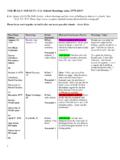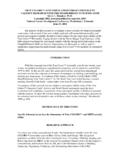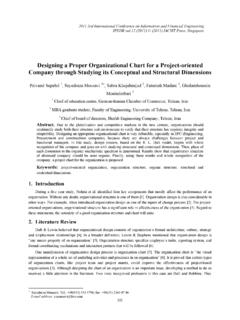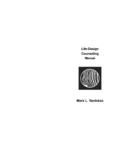Transcription of Introducing Qualitative Hypothesis-Generating …
1 1 Introducing QualitativeHypothesis-Generating ResearchThe Yeshiva University Fatherhood ProjectRESEARCH BEGINS WITH CURIOSITY about the world. We assumethat you are reading this book because you find a particular phenomenoninteresting and want to understand it better. For example, you may havequestions about trauma, or fathering, or divorce, or immigration, to listsome of the topics that our research team has studied. This book will teachyou how to use a very powerful research method, Qualitative research , toanswer your questions and learn more about your field of Qualitative research is quite diverse. Some methodologiesincluded in this approach are: participant observation, fieldwork, ethnog-raphy, unstructured interviews, life histories, textual analysis, discourseanalysis, and critical cultural history, and this list is by no means our purpose, Qualitative research can be defined as follows: Qualitative research is research that involves analyzing and interpreting textsand interviews in order to discover meaningful patterns descriptive of a par-ticular Qualitative approach to research design leads to studies that arequite different from those designed using the more traditional traditional approach, often referred to as quantitative research ,leadsto hypothesis-testingresearch, whereas the Qualitative approach leads tohypothesis-generatingresearch.
2 This chapter will describe the differencebetween the two approaches, and spell out the conditions under whichhypothesis-generating research is an appropriate research strategy. We willillustrate the discussion by describing our own research program, theYeshiva University Fatherhood research as an Alternativeto Hypothesis-Testing ResearchPerhaps the best way to explain the difference between quantitative hy-pothesis-testing research and Qualitative Hypothesis-Generating research isto describe how we became Qualitative researchers. This occurred as a re-sult of our research program investigating fathers and fathering, theYeshiva University Fatherhood undertook the project for both personal and professional with the personal reasons, we ourselves had intense positive andnegative feelings toward our own fathers. In addition, we were both ac-tively involved in raising our children, and were struggling to create fami-lies where fathers and mothers had an equal role in child professional reasons stemmed from the fact that traditional theo-ries of child development had neglected the role of the father.
3 They as-sumed instead that the mother was the most important figure in the child slife, and that the father s role was simply to support the mother. When webegan our work, the field had begun to challenge this assumption ( ,Cath, Gurwitt, & Gunsberg, 1989; Lamb, 1987) and we wanted to con-tribute to this developing body of research and were committed to studying fatherhood from a multicultural di-versity perspective. Much of the research on fathering studied only tradi-tional Euro-American families, which we found unnecessarily limiting,both in terms of developing theory and in terms of developing clinicallyuseful knowledge. Thus, we decided to study fathers drawn from the en-tire spectrum of cultural, ethnic, and sexual orientations. Ultimately, ourresearch included such diverse subcultures as Haitian American fathers,4 Introducing Qualitative Hypothesis-Generating ResearchPromise Keeper fathers, divorced fathers, gay fathers, Latino fathers,young unmarried black fathers, stepfathers, and white middle-class fathersin dual-career couples.
4 To date we have completed data collection onover 400 we thought about designing research to investigate fatherhood froma multicultural diversity perspective, we realized that traditional quantita-tive hypothesis-testing research wasn t suitable for our purposes. To ex-plain why, we must describe traditional hypothesis-testing research in a bitmore detail. Some of you are already familiar with this material from re-search design courses, but for those of you who are not, we briefly reviewit. Hypothesis-testing research may be defined as follows:Hypothesis testing research investigates a phenomenon in terms of a rela-tionship between an independent and dependent variable, both of which aremeasurable numerically. This relationship is called a hypothesis. The aim ofthe research is to test whether the hypothesized relationship is actually true,using statistical is a simplified example of how a hypothesis-testing researchermight design a study of fatherhood.
5 She would begin by choosing a de-pendent variable to define the phenomenon of fatherhood, such as a fa-ther s affection for his child. To study this variable in research she wouldhave to make it measurable, so she might have the fathers rate their affec-tion for their child on a scale from 1 (the lowest) to 7 (the highest).Then she would decide on an independent variable, by which is meanta variable likely to have an effect on the dependent variable of might choose as an independent variable the father s contact with hischild, as measured by the number of minutes the father spends in the sameroom with his , she would state a hypothesis about the relationship between theindependent and the dependent variable. She might hypothesize that themore contact a father has with his child, the greater his affection for thatchild. This hypothesis could be tested experimentally by seeing whetherthere is a statistically significant correlation between the independent anddependent example, although simplified, illustrates the problems we had inusing the hypothesis-testing approach to study fatherhood from a multi- Introducing Qualitative Hypothesis-Generating research 5cultural diversity perspective.
6 There were two basic difficulties. First, wedidn t know enough to state meaningful hypotheses, particularly for culturesdifferent from our own. The hypothesis above is plausible for our own whitemiddle-class culture, but it is less likely to be true in other cultures. For ex-ample, a middle-class father may be able to make enough money to sup-port his family with one job. For him, choosing to spend time in his child spresence, rather than in leisure-time pursuits that would exclude his chil-dren, may be an accurate reflection of his affection for his child. However,a working-class Latino immigrant father may have to work two full-timejobs to earn enough money to provide tutoring for his children so that theycan improve their high school grades. Thus, affection for his children maycause him to spend less, rather than more, time in contact with , not only did we not know enough to state meaningful hy-potheses; we didn t even know enough to select meaningful independent anddependent variables.
7 For example, when we studied Haitian American fa-thers, we discovered that their religious belief was an important variable inunderstanding how they defined good fathering. We would not have ex-pected this based on our experience with our own secular second problem we had with the hypothesis-testing approach isthat for clinical and theoretical reasons we were interested in understandingthe subjective experience of fathers, and because variables must be defined nu-merically in hypothesis-testing research , they cannot reflect subjective experi-ence. Even if the study yielded significant results, we would know very lit-tle about the fathers subjectiveexperience, that is, what they actually feltabout their children. In order to understand something meaningful abouthis affection for his child, we wanted the following and other does a father s affection for his child feel like?What does it mean for a father to be in the presence of his child?
8 Does he remember times that he was with his own father or mother?Does he feel nervous being left in charge of an infant, without his wifeor another woman present?In order to address the questions that we were interested in, wesearched for a research method that would not require us to state a hy-6 Introducing Qualitative Hypothesis-Generating Researchpothesis prior to beginning our investigation, and that also would allow usto study subjective experience directly. This led us to do hypothesis-gen-erating research using the grounded research Using theGrounded Theory MethodThe grounded theory method allows the researcher to begin a researchstudy without having to test a hypothesis. Instead, it allows her to develophypotheses by listening to what the research participants say. Because themethod involves developing hypotheses after the data are collected, it iscalled Hypothesis-Generating research rather than hypothesis-testing re-search.
9 The grounded theory method uses two basic principles: (1) ques-tioning rather than measuring, and (2) generating hypotheses using theo-retical Rather Than MeasuringThe grounded theory method allows the researcher to acknowledge thatshe may not know enough to formulate meaningful hypotheses. It uses theresearch participants as a source of knowledge. After all, they are expertson the phenomenon being studied because they are experiencing it di-rectly. This methodology questions the research participants about theirsubjective experience and generates hypotheses from their answers. For ex-ample, our hypotheses about Haitian fatherhood were developed fromwhat the Haitian fathers said in their interviews with Hypotheses Using Theoretical CodingThe grounded theory method uses a data analysis procedure called theo-retical codingto develop hypotheses based on what the research partici-pants say. Grounded theory derives its name from the fact that theoreticalcoding allows you to ground your hypotheses in what your research par-ticipants discussion so far has covered the application of grounded theory tointerview data, and, as you will see later, our illustrative data will be fromgroup interviews, that is, focus groups.
10 You should be aware, however,that the data for Qualitative research can also include observed behavior, Introducing Qualitative Hypothesis-Generating research 7participant observation, media accounts, cultural artifacts, among , the techniques and illustrations we present here cover an importantpart of the field of Qualitative research , but by no means all of this qualification in mind, Qualitative Hypothesis-Generating re-search may be defined as Hypothesis-Generating research involves collecting interview datafrom research participants concerning a phenomenon of interest, and thenusing what they say in order to develop hypotheses. It uses the two princi-ples of (1) questioning rather than measuring and (2) generating hypothe-ses using theoretical a systematic method for doing Qualitative hypothesis-gener-ating research is the subject of the rest of this book. We will use examplesfrom our own research to illustrate our methodology.






![-:HSTCQE=UX]ZXU - OECD.org](/cache/preview/9/0/f/7/1/8/4/1/thumb-90f7184114476572160c1ff26e5abd2d.jpg)


